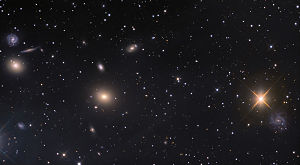NGC 1060
| Galaxy NGC 1060 |
|
|---|---|

|
|
| Panoramic image with a 60 cm telescope of the galaxies NGC 1057 , NGC 1060, NGC 1061 , NGC 1066 , PGC 10331 and NGC 1067 (from right to left, NGC 1060 is slightly below and slightly to the left of the center of the image) and other galaxies that are not listed in the New General Catalog . | |
| AladinLite | |
| Constellation | triangle |
|
Position equinox : J2000.0 , epoch : J2000.0 |
|
| Right ascension | 02 h 43 m 15.0 s |
| declination | + 32 ° 25 ′ 30 ″ |
| Appearance | |
| Morphological type | S0-: |
| Brightness (visual) | 12.0 mag |
| Brightness (B-band) | 13.0 likes |
| Angular expansion | 2.3 ′ × 1.7 ′ |
| Position angle | 75 ° |
| Surface brightness | 13.6 mag / arcmin² |
| Physical data | |
| Affiliation | WBL 85 NGC 1060 group LGG 72 |
| Redshift | 0.017312 ± 0.000073 |
| Radial velocity | 5190 ± 22 km / s |
|
Stroke distance v rad / H 0 |
(236 ± 17) · 10 6 ly (72.5 ± 5.1) Mpc |
| history | |
| discovery | William Herschel |
| Discovery date | September 12, 1784 |
| Catalog names | |
| NGC 1060 • UGC 2191 • PGC 10302 • CGCG 505-038 • MCG + 05-07-035 • 2MASX J02431504 + 3225300 • GC 594 • H III 162 • h 257 • GALEX ASC J024315.06 + 322529.3 • LDCE 176 NED028 | |
NGC 1060 is an elliptical galaxy of the Hubble type E / S0 in the constellation Triangle in the northern sky . It is estimated to be 236 million light years from the Milky Way and about 160,000 light years in diameter.
The Type Ia supernova SN 2004fd was observed here.
The object was discovered on September 12, 1784 by the German-British astronomer William Herschel .
Web links
Commons : NGC 1060 - collection of images, videos, and audio files
